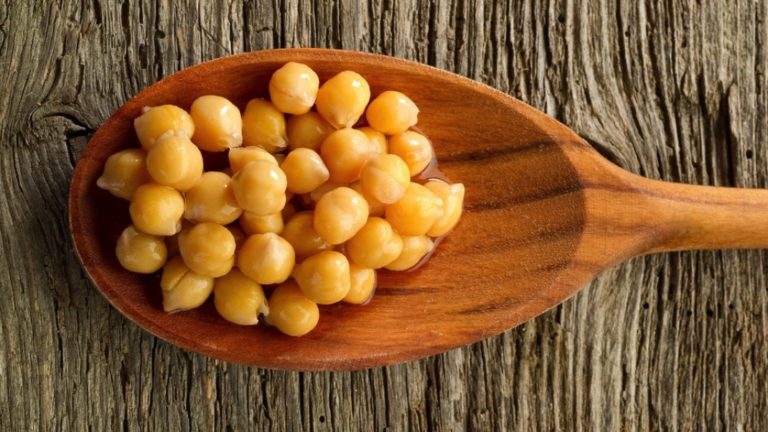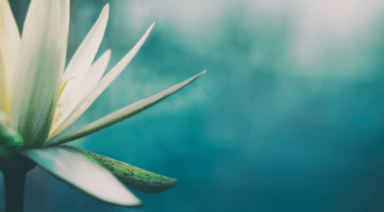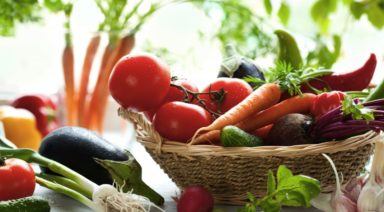Mighty Sattvic Hummus

Many people love hummus but have a really hard time digesting it. One reason can be that you are sensitive to an ingredient like fillers or preservatives if the hummus is store bought. Another reason may be that you are sensitive to the garbanzo beans, or chick peas, that are traditionally used in hummus. Or maybe you are sensitive to garlic.
In Ayurveda, garlic is praised for its Rasayana or rejuvenating, qualities, which make it a desired food. In the West we know garlic for it’s antiseptic and anti-inflammatory properties and the ability to help lower cholesterol and blood pressure. Yet an increasing number of people seem to be developing sensitivities and adverse reactions to garlic, which can range from light-headedness and skin rashes to more severe reactions such as nausea, vomiting, hot flashes and digestive issues like diarrhea.
Apart from these physical reactions, garlic in the yogic system is often avoided as it increases Rajas, the quality that can make our mind overactive and give us grief falling asleep. It is often suggested to avoid garlic before meditation or in (Vata) anxiety disorders.
For those who want to (or have to) avoid garlic but really enjoy a good hummus, here is a recipe to the rescue.
The traditionally used garlic in this recipe has been replaced with leek, which is much milder in action then garlic yet still gives the hummus enough of a pungent quality for you to enjoy as a dip or spread with your favourite raw or steamed veggies or crackers.
Not only does this garlic-free hummus taste just as delicious as its traditional cousin, it is also much kinder to eat before your yoga class where the odor of garlic breath may otherwise cause your fellow class members to have rather un-yogic thoughts.
Sattvic Garlic-Free Hummus
Ingredients:
1 cup cooked, or 1 cup canned Chickpeas
2 tbsp Tahini
2 tbsp finely chopped Leek (white and green parts)
1 small Red Chili
1 heaping tsp Cumin Seed Powder
1 tsp Sea Salt
¼ Fresh squeezed Lemon Juice
1 tbsp finely chopped Chives
1 tbsp finely chopped Parsley
Small pinch of Hing (Asafoetida, use very little, a small amount goes far)
3 tbsp Extra Virgin Olive Oil
** Directions:**
Put all ingredients in a food processor or Vitamix and process until you get to the desired consistency (about 40 sec in Vitamix). If using a food processor, chop the herbs and Leek very finely so you don’t end up with chunky Hummus. Add a little water if you like your Hummus more like a dressing or dip.
What's your Ayurvedic dosha? Take this quiz and find out

The balance of your Ayurvedic doshas, also known as prakruti, is a key part of understanding your holistic health.
Doshas are the three energies found in nature, and also in the human body. They are broken down into three types: vata, pitta and kapha. The doshas are responsible over our bodies, minds, emotions, and thoughts. From birth, we are each individually made with a very specific blend of the five basic elements: ether, air, fire, water, and earth. That unique blend is your prakruti, or what uniquely constitutes your individual body, and can be broken down by a combination of the three doshas: vata (ether + air), pitta (fire + water), and kapha (water + earth).
The three doshas are the building blocks to understanding our prakruti, and once you understand which is your dominant dosha, you can know what your balanced state looks like. This is vital, as through this lens you can spot exactly when your body goes out of balance, and how to bring it back into balance. Humans are being of nature, constructed from the same five elements, and thus can use the opposing elements as needed to bring us back into balance.
It all hinges on knowing your doshas, however. You can get a general sense of where your dosha balance lies, and go from there to correct the problems. You can even seek out the help of an Ayurvedic practitioner, who can take a look at your insights and prescribe anything from food and herbs to a new lifestyle. Thanks, Ayurveda!
Tally up the number of v’s, p’s, and k’s you receive (standing for vata, pitta, and kapha), whichever you have the most of is your dominant dosha:
1. Physique
- v) I am a slender person and I hardly gain weight
- p) I am medium build
- k) I am well built and I gain weight no matter what I do
2. Skin
- v) My skin is dry, thin, and itches often
- p) My skin looks flushed; I have lots of moles and freckles on my body
- k) My skin is smooth and soft, it looks pale sometimes
3. Hair
- v) My hair is dry, thin and brittle
- p) My hair is neither dry nor oily (for men: I have a receding hairline)
- k) My hair is thick, full, lustrous, and slightly oily
4. Face
- v) My face is oval
- p) My face is triangular (pointed chin, prominent jaw line)
- k) My face is round
5. Eyes
- v) My eyes are small; they feel dry often and have a bit of dullness (usually brown)
- p) My eyes are medium in shape; sharp & penetrating (usually blue)
- k) My eyes are big and round in shape, full eyelashes
6. Hands
- v) My hands are generally dry, rough; slender fingers; dry nails
- p) My hands are generally moist, pink; medium fingers; soft nails
- k) My hands are generally firm, thick; thick fingers; strong & smooth nails
7. Joints
- v) My joints are small, prominent bones, and often crack
- p) My joints are medium and loose
- k) My joints are large, sturdy, with lots of muscle surrounding
8. Activities
- v) I am a very active person (always on the go, mind constantly thinking)
- p) I like to think before I do anything
- k) I am steady and graceful (I don’t like to rush)
9. Actions
- v) I walk fast and talk fast
- p) My actions are very thoughtful and precise
- k) I like a slower pace and I take my time to accomplish things
10. Sleep
- v) I do not sleep soundly at night. I tend to toss and turn. I wake up early in the morning
- p) I am a light sleeper but if something wakes me up, I can go back to sleep easily
- k) I am a heavy sleeper
11. Appetite
- v) Varies, sometimes I feel hungry, sometimes not, I feel anxious if I don’t eat
- p) I always feel hungry. If I don’t eat I get irritable and angry
- k) I don’t feel very hungry. I can go without food easily for a day
12. Bowel Movement
- v) I tend to have constipation and can go a day or two without a bowel movement
- p) I am regular and sometimes stools are loose (tend to get diarrhea)
- k) I have no problem. I wake up to go to the bathroom.
13.Voice
- v) My voice tends to be weak or hoarse
- p) I have a strong voice, I may get loud sometimes
- k) My voice is deep, has good tone
14. Emotions
- v) I am a born worrier, I often feel anxious and nervous
- p) If things don’t happen my way, I feel irritable and angry
- k) I am a happy person, very caring and loving
15. Weather Preference
- v) I love warm and humid weather
- p) I enjoy cool weather, I dislike a warm climate
- k) I like warm but dry weather
16. Sweating
- v) I sweat little but not much
- p) I sweat profusely and it might have an unpleasant odor
- k) I never sweat, unless working very hard
17. Memory
- v) I remember quickly and forget quickly
- p) I remember what I want to remember and never forget
- k) It takes me a while to remember, but once I do I never forget
18. Actions
- v) I tend to be spontaneous
- p) I am a list maker. Unless I plan, I don’t do anything
- k) I don’t like to plan, I prefer to follow others
19. Stamina
- v) I like to do things in spurts and I get tired very easily
- p) I have medium stamina
- k) I can work long hours and maintain good stamina
20. Mind
- v) My mind gets restless and racing easily
- p) I get impatient easily
- k) It takes a lot to make me mad. I usually feel very calm
21. Decision Making
- v) I change my mind more often and will take time to make a decision
- p) I can make a decision easily and stick with it
- k) I want others to make the decisions
22. Personality
- v) “Is it too late to change my mind”?
- p) “It’s my way or the highway”
- k) “Don’t worry, be happy!”
23. Sports
- v) I like action
- p) I like to win
- k) I like to have fun
24. Health Problems
- v) My symptoms are mainly pain, constipation, anxiety and depression
- p) I often get skin infections, fevers, heart burn, and hypertension
- k) I tend to get allergies, congestion, weight gain and digestive problems
25. Hobbies
- v) I like art (drawing, painting, dance) and travel
- p) I like sports, politics, and things that get my adrenaline pumping
- k) I like nature, gardening, reading, and knitting





































